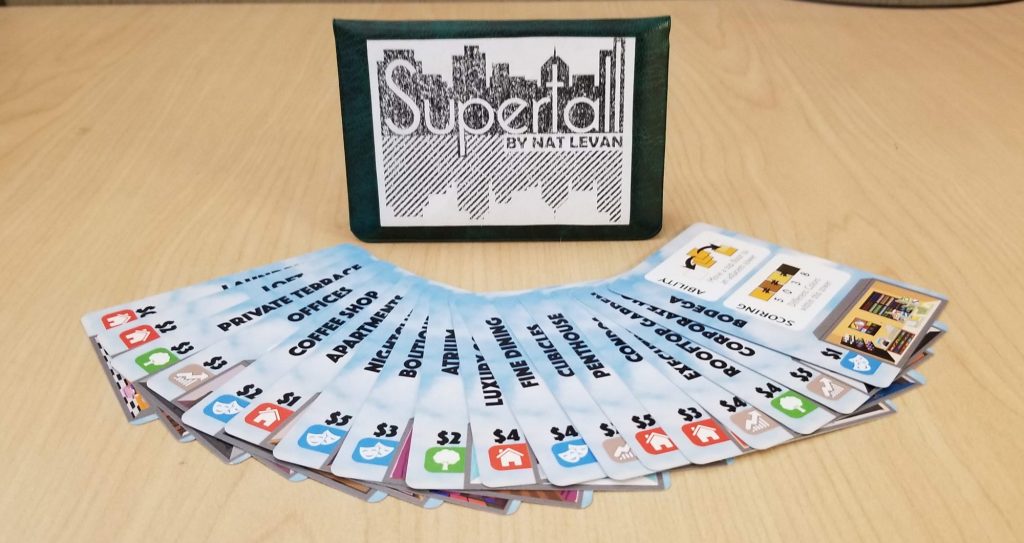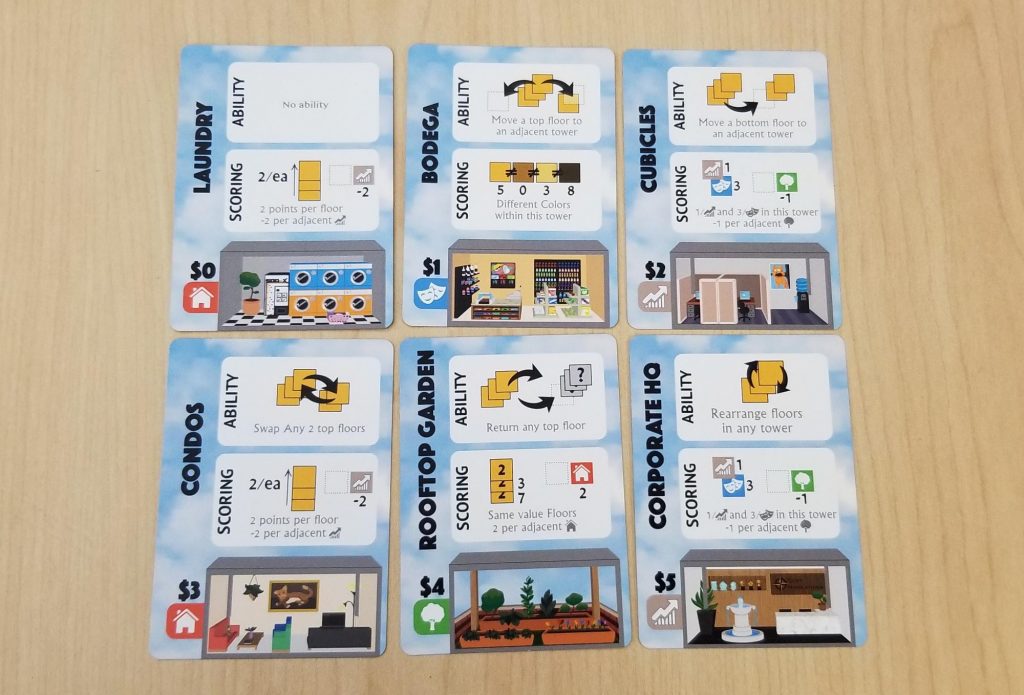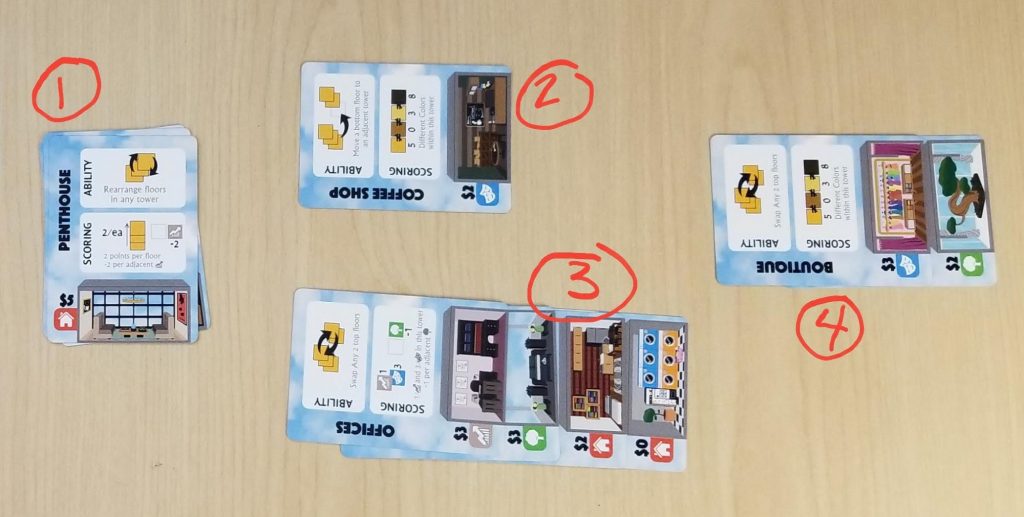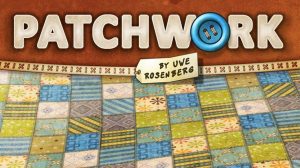Disclosure: Meeple Mountain received a free copy of this product in exchange for an honest, unbiased review. This review is not intended to be an endorsement.
138 Feet. That was the height of what is widely regarded as the world’s first steel framed skyscraper. A mere ten stories. In its day, the Home Insurance Building in Chicago, Illinois was one of the most impressive structures on the planet. Were it still around today, you’d hardly bat an eye at it. That’s because these are the days of the Supertalls and the Megatalls – skyscrapers that reach above the clouds and tickle the heavens with their mighty spires.

Overview
In the game of Supertall, 2 to 3 players take on the roles of developers presenting their plans for new skyscrapers to the city planners in the hopes of becoming the most successful real estate moguls the city has ever known. The game is made up of a deck of 18 multi-use cards. Each card can be used for its special ability, added to an existing building or used to create a new one, or to invalidate a building type by bogging it down with red tape at City Hall. Once the final card has been drawn and placed, the scores are tallied and a winner will emerge.
If you’ve only come here for my opinion of Supertall, feel free to scroll down to the Thoughts section. For the rest of you, let’s talk about how Supertall is played.
Setup
First, the deck of cards is shuffled and one is placed face up in between the players. This is City Hall. Then each player receives one card which they place into one of their “building sites” (their play area). The number of possible building sites depends on the number of players. In a two-player game, each player will have 3. In a three-player game, each player will have 2. This layout also determines adjacency (which we will cover shortly).

The remaining cards are split up into three roughly equal piles and set face down next to the playing area. A starting player is selected by some means and you are ready to begin.
Understanding Adjacency
Central to the game is the concept of adjacency. Adjacency not only informs final scoring, but it also determines how each opponent is able to affect the other opponents. Let’s consider an example:

In the 2-player example here, the red arrows show which buildings are adjacent to which. Each player’s front skyscrapers are able to directly affect both City Hall as well as the skyscrapers of the opponent’s directly in front of them. The skyscrapers in the rear can only affect/be affected by the 2 skyscrapers that sit between them and City Hall.
The Turn
On a player’s turn, they will draw a Plan card from one of the three piles and take one of the following actions:
Rezone: use the card for its action – each card has a specific associated action which will allow them to move cards around, discard cards from skyscrapers, or manipulate the game state in some other way. Cards used in this way are then placed onto the bottom of one of the existing draw piles.

Submit Design: add the card to an existing skyscraper (even their opponent’s) – each card added to an existing skyscraper must have a value equal to or higher than the card beneath it.
Scrap Plans: discard the Plan card to City Hall – the top card on the City Hall pile will determine which card type does NOT score at the end of the game.
Then it is the next player’s turn.
Endgame and Scoring
The game comes to an end when there are only 2 or 3 cards (dependent on player count) left in the draw piles. Each player then gets one final turn. Anyone that did not get an equal number of turns earns a victory point (VP). Then the total dollar value of each skyscraper is determined and the person that has the highest valued building earns 2 VP.

Each building is then scored according to the card on the top floor of that building. Any building whose top floor type matches the top floor type of City Hall, though, will not score. Buildings score in various ways: some will score for every floor in the building, some score based on how many Plan cards of a specific type have been added to the building, while some even receive negative points based on the types of buildings which are adjacent to them.
The person with the highest score wins.
Thoughts
I previously reviewed Nat Levan’s game New Bedford and more recently, Nantucket. I was highly impressed by both. When I was offered the opportunity to take Supertall for a spin, I was excited. Knowing that the game was being published by Button Shy Games and having experienced Nantucket multiple times, I was looking forward to seeing just what Mr. Levan could do with eighteen cards.
The beginning of each game that I have played starts out pretty much the same. Each player is just taking turns playing Plan cards onto their building sites. Even though the abilities on the cards are interesting, it’s difficult to really affect the game in any meaningful way at this stage. There are simply not enough cards in play and not enough information to make educated decisions.
Then the skyscrapers start hitting the two or three story mark and scoring opportunities begin to emerge. This is when things start getting interesting. Oftentimes you’ll find yourself holding a card that could help you tremendously, but could actually hurt your opponent were you to play it onto one of their structures. Do you help yourself or do you risk giving your opponent extra points in an attempt to hurt them? There’s always the possibility that they’ll get the opportunity to shuffle their cards around later. Maybe your best bet would be to scrap the plan, see what they focus on, and try to maneuver City Hall appropriately to nullify their entire building. For such a small game, it is packed with decisions like these.
My only real issue with the game is that it feels too small. Just when things are really starting to get interesting, the game’s over. It really makes me wish there were more cards. I understand that small wallet-sized cards games are Button Shy Games’s thing, but I really think that a game like Supertall deserves a bigger stage. While the small size keeps the game portable, manageable, and easy to teach and learn, it also places undue constrictions on the game. Supertall isn’t a bad game by any means, but it definitely feels like it’s giving up a lot of potential in the quest to fit inside of your wallet.










